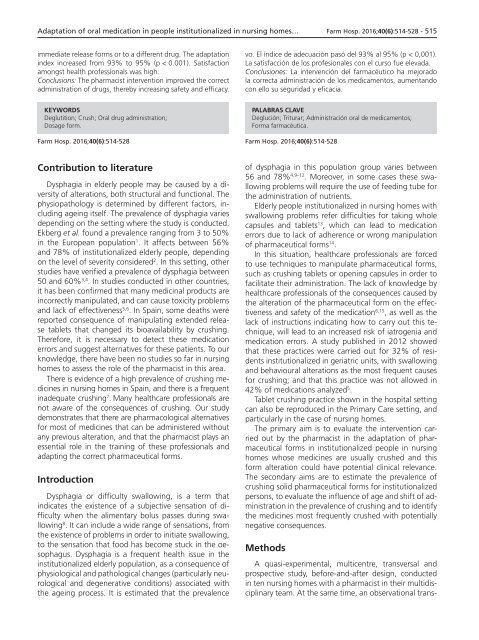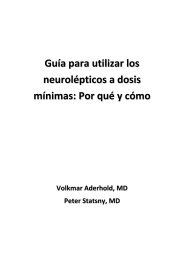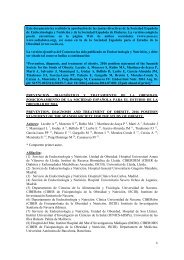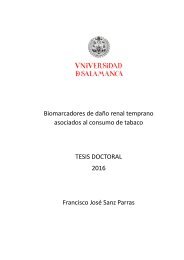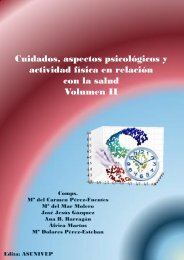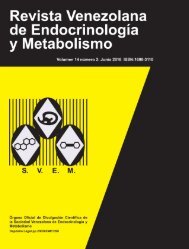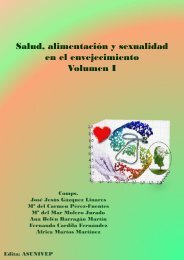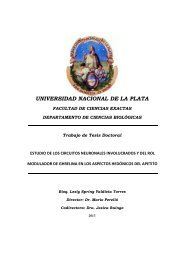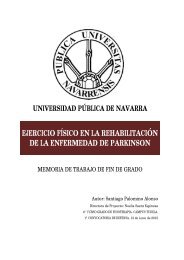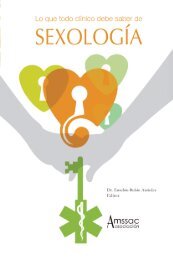Noviembre-Diciembre
156_v40n6(1)
156_v40n6(1)
Create successful ePaper yourself
Turn your PDF publications into a flip-book with our unique Google optimized e-Paper software.
Adaptation of oral medication in people institutionalized in nursing homes… Farm Hosp. 2016;40(6):514-528 - 515<br />
immediate release forms or to a different drug. The adaptation<br />
index increased from 93% to 95% (p < 0.001). Satisfaction<br />
amongst health professionals was high.<br />
Conclusions: The pharmacist intervention improved the correct<br />
administration of drugs, thereby increasing safety and efficacy.<br />
vo. El índice de adecuación pasó del 93% al 95% (p < 0,001).<br />
La satisfacción de los profesionales con el curso fue elevada.<br />
Conclusiones: La intervención del farmacéutico ha mejorado<br />
la correcta administración de los medicamentos, aumentando<br />
con ello su seguridad y eficacia.<br />
KEYWORDS<br />
Deglutition; Crush; Oral drug administration;<br />
Dosage form.<br />
Farm Hosp. 2016;40(6):514-528<br />
PALABRAS CLAVE<br />
Deglución; Triturar; Administración oral de medicamentos;<br />
Forma farmacéutica.<br />
Farm Hosp. 2016;40(6):514-528<br />
Contribution to literature<br />
Dysphagia in elderly people may be caused by a diversity<br />
of alterations, both structural and functional. The<br />
physiopathology is determined by different factors, including<br />
ageing itself. The prevalence of dysphagia varies<br />
depending on the setting where the study is conducted.<br />
Ekberg et al. found a prevalence ranging from 3 to 50%<br />
in the European population 1 . It affects between 56%<br />
and 78% of institutionalized elderly people, depending<br />
on the level of severity considered 2 . In this setting, other<br />
studies have verified a prevalence of dysphagia between<br />
50 and 60% 3,4 . In studies conducted in other countries,<br />
it has been confirmed that many medicinal products are<br />
incorrectly manipulated, and can cause toxicity problems<br />
and lack of effectiveness 5,6 . In Spain, some deaths were<br />
reported consequence of manipulating extended release<br />
tablets that changed its bioavailability by crushing.<br />
Therefore, it is necessary to detect these medication<br />
errors and suggest alternatives for these patients. To our<br />
knowledge, there have been no studies so far in nursing<br />
homes to assess the role of the pharmacist in this area.<br />
There is evidence of a high prevalence of crushing medicines<br />
in nursing homes in Spain, and there is a frequent<br />
inadequate crushing 7 . Many healthcare professionals are<br />
not aware of the consequences of crushing. Our study<br />
demonstrates that there are pharmacological alternatives<br />
for most of medicines that can be administered without<br />
any previous alteration, and that the pharmacist plays an<br />
essential role in the training of these professionals and<br />
adapting the correct pharmaceutical forms.<br />
Introduction<br />
Dysphagia or difficulty swallowing, is a term that<br />
indicates the existence of a subjective sensation of difficulty<br />
when the alimentary bolus passes during swallowing<br />
8 . It can include a wide range of sensations, from<br />
the existence of problems in order to initiate swallowing,<br />
to the sensation that food has become stuck in the oesophagus.<br />
Dysphagia is a frequent health issue in the<br />
institutionalized elderly population, as a consequence of<br />
physiological and pathological changes (particularly neurological<br />
and degenerative conditions) associated with<br />
the ageing process. It is estimated that the prevalence<br />
of dysphagia in this population group varies between<br />
56 and 78% 4,9–12 . Moreover, in some cases these swallowing<br />
problems will require the use of feeding tube for<br />
the administration of nutrients.<br />
Elderly people institutionalized in nursing homes with<br />
swallowing problems refer difficulties for taking whole<br />
capsules and tablets 13 , which can lead to medication<br />
errors due to lack of adherence or wrong manipulation<br />
of pharmaceutical forms 14 .<br />
In this situation, healthcare professionals are forced<br />
to use techniques to manipulate pharmaceutical forms,<br />
such as crushing tablets or opening capsules in order to<br />
facilitate their administration. The lack of knowledge by<br />
healthcare professionals of the consequences caused by<br />
the alteration of the pharmaceutical form on the effectiveness<br />
and safety of the medication 6,15 , as well as the<br />
lack of instructions indicating how to carry out this technique,<br />
will lead to an increased risk of iatrogenia and<br />
medication errors. A study published in 2012 showed<br />
that these practices were carried out for 32% of residents<br />
institutionalized in geriatric units, with swallowing<br />
and behavioural alterations as the most frequent causes<br />
for crushing; and that this practice was not allowed in<br />
42% of medications analyzed 5 .<br />
Tablet crushing practice shown in the hospital setting<br />
can also be reproduced in the Primary Care setting, and<br />
particularly in the case of nursing homes.<br />
The primary aim is to evaluate the intervention carried<br />
out by the pharmacist in the adaptation of pharmaceutical<br />
forms in institutionalized people in nursing<br />
homes whose medicines are usually crushed and this<br />
form alteration could have potential clinical relevance.<br />
The secondary aims are to estimate the prevalence of<br />
crushing solid pharmaceutical forms for institutionalized<br />
persons, to evaluate the influence of age and shift of administration<br />
in the prevalence of crushing and to identify<br />
the medicines most frequently crushed with potentially<br />
negative consequences.<br />
Methods<br />
A quasi-experimental, multicentre, transversal and<br />
prospective study, before-and-after design, conducted<br />
in ten nursing homes with a pharmacist in their multidisciplinary<br />
team. At the same time, an observational trans-


